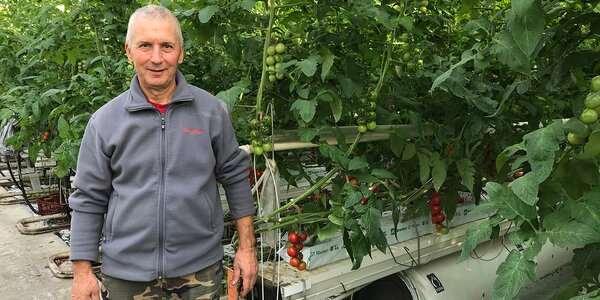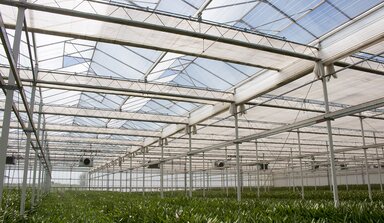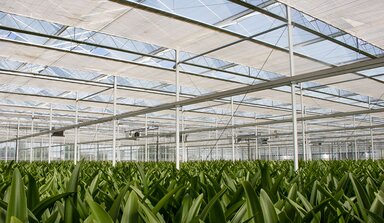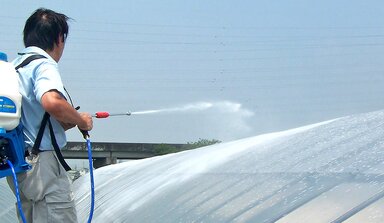Three layers of ReduSol absorb extreme summer heat
Normally, he would apply two layers of ReduSol. But in response to the recent hot summers, Jean-Yves Scardigli decided on a new system: three layers applied in May, June and July. That works well in the hot climate of southern France.
Together with his son Cyril, Jean-Yves Scardigli has six hectares of tomato nurseries around sixty kilometres from Marseille. ‘In summer, the amount of sunlight makes is impossible not to use a coating here. In fact, the heat generated by the sun creates problems for fruit set and good fruit development,’ he explains.
It took a long time before Jean-Yves and Cyril found the right approach and the hot summers of recent years provided an additional challenge. ‘We've been using ReduSol for the last five years. Before that, we used different products. First a type of spray chalk that we had to apply several times throughout the season. Then a product based on mica that was no longer suited to the temperature increase of recent years,’ he remembers.

Jean-Yves Scardigli
Happy with ReduSol
Through local colleagues and his crop adviser, he discovered ReduSol. ‘From the very first season, it was a success and we're still happy with it,’ he says.
Normally, he applies two layers: the first at the end of April and the second at the end of May. But with the summers getting hotter, that's no longer enough. So last year he applied three layers, the last one in early July. 6 buckets per hectare each time. ‘The layer in early May helps regulate the first heat while allowing plants to still benefit from the light. The second layer in early June is important because that's when the greenhouse starts to heat up, and the coating avoids fruit set problems. In July, we need to provide heavy shading, which allows to maintain an optimal fruit quality. We therefore apply an extra layer over the top,’ says Jean-Yves. This way, he maintains the balance between using the light and protecting the crop.
All the layers are applied by helicopter, a fast and efficient method. Within three hours, he can finish the entire six hectares. That means we don't have to keep the vents closed for so long during the application,’ he explains.
The grower always contacts the helicopter company well in advance so that they can apply the coating at the right time. Only the mistral sometimes causes problems.
They also coat the side walls with ReduSol. With a spray gun, they apply eight buckets for six hectares. This remains there throughout the year and if the layer wears off, they spray again. ‘Direct light from the side walls doesn't do the plants any good. By painting the sides we preserve the quality of our fruits,’ he says.
At the end of August, the helicopter sprays ReduClean over the greenhouse covers and the autumn storms clean the greenhouses again.
ReduHeat
‘We're very happy with our approach and have never had any problems. Under ReduSol, we see well-formed, nicely coloured tomatoes. We also estimate that the plants use 20% less water. That's very welcome because we can't water them more than three times an hour. The employees are also very glad that we coat in spring. It makes the climate in the greenhouse much more pleasant to work in,’ he says.
And the disadvantages? ‘I can only think of one: if it was cloudy for a long period in June, you'd lose too much light. But that didn't happen last year,’ he says.
Jean-Yves sees even more potential to improve his system, namely by replacing the first layer by ReduHeat in May. ‘That would allow us to optimise the amount of light in spring but lower the temperature. They would still apply the two layers of ReduSol in June and July. In 2019, that third layer really made the difference.’


